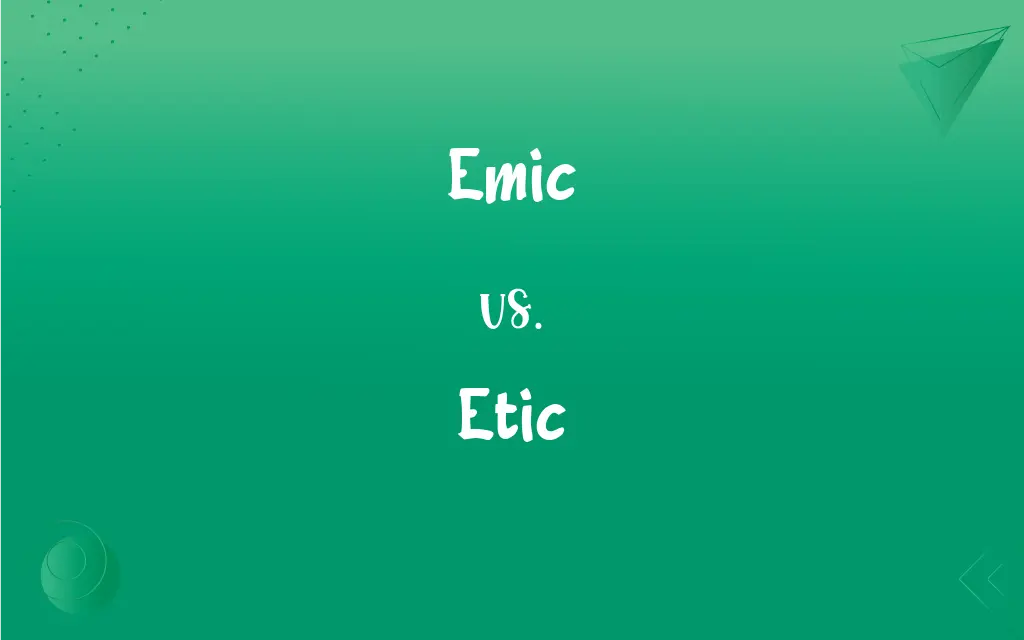Emic vs. Etic: What's the Difference?
Edited by Aimie Carlson || By Janet White || Published on February 15, 2024
Emic approach studies cultures from within, using insider perspectives, while etic approach examines cultures from an external, objective viewpoint.

Key Differences
The emic approach in anthropology and social sciences involves understanding cultures, behaviors, and customs from the perspective of the insider, or the native viewpoint. Conversely, the etic approach looks at these same aspects from an outsider's perspective, often using universal categories and concepts.
Emic analysis aims to uncover the cultural meanings and perceptions held by the members of the culture itself. It seeks to understand how they perceive and categorize the world, their rules for behavior, and their own cultural norms. In contrast, etic analysis uses the concepts and categories of the observer’s culture to describe and understand the observed culture.
Researchers using the emic approach immerse themselves in the cultural context and often learn the language and customs to gain a deep understanding. The etic approach, on the other hand, maintains a more detached, objective stance, often comparing multiple cultures using a standardized set of criteria.
An example of an emic approach might be studying religious rituals from the perspective of believers to understand their spiritual significance. In contrast, an etic approach might analyze the same rituals using a comparative framework that applies across different religions, focusing on patterns and similarities.
The emic approach can provide deep, nuanced understandings of specific cultures, but may lack generalizability. The etic approach offers broader, potentially more objective comparisons but can miss the unique aspects and internal meanings of individual cultures.
ADVERTISEMENT
Comparison Chart
Perspective
Insider, native viewpoint
Outsider, objective viewpoint
Focus
Cultural meanings, perceptions
Universal categories, patterns
Method
Immersion, cultural context
Detached, comparative analysis
Example Application
Studying rituals as believers see them
Analyzing rituals in a comparative framework
Advantages & Limitations
Deep, nuanced understanding, less generalizable
Broader comparisons, may overlook unique aspects
ADVERTISEMENT
Emic and Etic Definitions
Emic
In-depth exploration of cultural norms and values.
Her emic approach offered insights into the tribe's social structures.
Etic
Analysis using universal concepts applicable to all cultures.
Etic research categorized kinship terms across various cultures.
Emic
Analysis based on cultural members' perspectives.
Emic research on language uncovered meanings specific to that culture.
Etic
Emphasizes comparative, cross-cultural study.
An etic study showed common patterns in economic systems globally.
Emic
Emphasizes subjective, insider interpretation.
The emic analysis highlighted the community's own explanations of their rituals.
Etic
Studying culture from an external, objective perspective.
The etic approach compared marriage customs across different societies.
Emic
Understanding culture from the insider's viewpoint.
The emic study revealed how the community uniquely perceives time.
Etic
Detached from cultural-specific meanings and contexts.
Using an etic view, the festival was analyzed as a form of social cohesion.
Emic
Focuses on internal cultural significance and meaning.
Using an emic perspective, the ceremony's symbolic importance was understood.
Etic
Focuses on generalizations and broad patterns.
The etic perspective identified universal aspects of religious practices.
Emic
Of or relating to phenomena considered as meaningful structural units within a system such as a language or culture.
Etic
Of or relating to features or items analyzed without considering their role as a structural unit in a system such as a language or a culture.
Emic
Of or pertaining to the analysis of a cultural system or its features from the perspective of a participant in that culture.
Etic
Of or pertaining to analysis of a culture from a perspective situated outside all cultures.
FAQs
What's the main focus of the etic approach?
It focuses on universal categories and cross-cultural comparisons.
Can emic and etic approaches be combined?
Yes, combining both can provide a more comprehensive understanding.
Is the emic approach subjective?
Yes, it's based on the subjective views of cultural members.
Is etic research always comparative?
Often, as it looks for patterns and similarities across cultures.
Can the emic approach be biased?
It can be, due to its reliance on insider perspectives.
What does etic mean?
It refers to an objective, outsider's analysis of culture.
What is the emic approach?
It's the study of culture from an insider's perspective.
What is an example of an emic study?
Studying a festival's meaning within a specific culture.
What skills are needed for emic research?
Cultural sensitivity, language proficiency, and empathy.
Do emic studies require cultural immersion?
Generally, yes, to understand the insider perspective.
Are etic studies less detailed than emic?
They might be, as they often prioritize breadth over depth.
Can etic research help in policy-making?
Yes, by providing a broad overview of cultural practices and issues.
What is a typical etic research example?
Comparing political systems across different cultures.
Does emic research require knowledge of the local language?
Usually, to accurately grasp the cultural context.
What disciplines use the etic approach?
It's used in anthropology, sociology, and psychology, among others.
How does emic research handle cultural diversity?
It respects and highlights the uniqueness of each culture.
Why opt for the etic approach?
To understand broad trends and make cross-cultural comparisons.
Is the etic approach useful for global studies?
Yes, it's effective for studying universal cultural patterns.
Can etic research misinterpret cultures?
It can, if it imposes external views without understanding the local context.
Why choose the emic approach?
For in-depth, culturally specific insights.
About Author
Written by
Janet WhiteJanet White has been an esteemed writer and blogger for Difference Wiki. Holding a Master's degree in Science and Medical Journalism from the prestigious Boston University, she has consistently demonstrated her expertise and passion for her field. When she's not immersed in her work, Janet relishes her time exercising, delving into a good book, and cherishing moments with friends and family.
Edited by
Aimie CarlsonAimie Carlson, holding a master's degree in English literature, is a fervent English language enthusiast. She lends her writing talents to Difference Wiki, a prominent website that specializes in comparisons, offering readers insightful analyses that both captivate and inform.































































